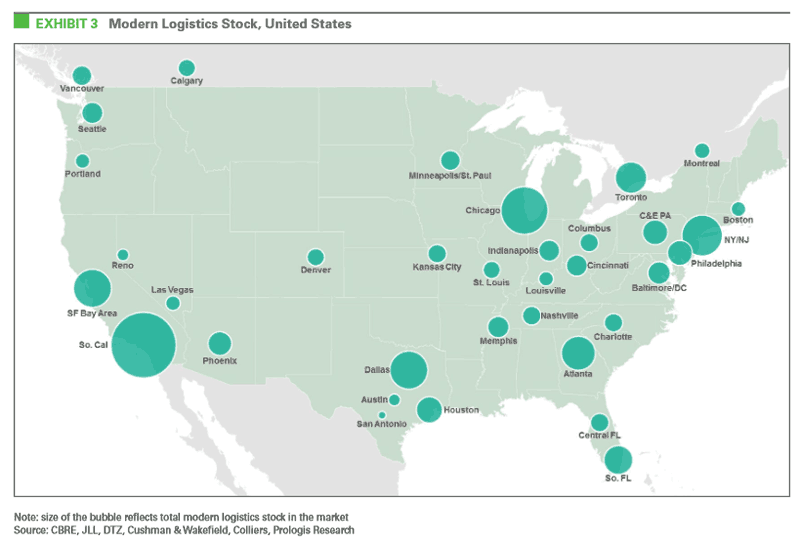From SCDigest's On-Target E-Magazine
- Sept. 1, 2015 -
Supply Chain News: Interesting Trends in Distribution Center Demand and Development
Increasing Demand for Smaller, Urban Facilities, while Logistics Clusters have Varying Levels of Modern Logistics Stock
SCDigest Editorial Staff
All told, there are relatively good times for real estate developers in the logistics space, with demand rising along with a modestly recovering economy, new requirements driven by ecommerce, and in the US at least continued growth in imports.
For example, a recent report from real estate firm CRBE said - not surprisingly - that demand is really picking for smaller facilities in metro areas to support rapid order fulfillment for ecommerce, such as same day or even faster delivery.
SCDigest Says: |
 |
| SCDigest would also mention that as the largest logistics clusters in the US continue to grow, the impact on workforce availability to take all these distribution jobs will likely be significant. |
|
What Do You Say?
|
|
|
|
Though the report was later pulled for some client reason, a CRBE executive tells SCDigest that the findings in the report, as summarized in a recent Wall Street Journal article, are still sound.
The CRBE research found that demand is rising for existing industrial structures under 200,000 square feet and located in the midst of high-population urban zones. That doesn't mean retailers and distributors are moving away from sprawling distribution centers far from urban centers, but are seeking to supplement those major DCs with smaller urban ones for local efulfillment. In fact, in many cases the flow of product is from the traditional large DCs to the urban ones.
Naturally enough, Amazon.com is leading the trend. After rolling out dozens of large fulfillment centers usually far from urban centers where costs for land and labor are low, Amazon began building a network of small service centers in and around London in 2013, and then took the strategy to the US thereafter. As of June, Amazon had 19 small spaces active in the country with several more due to open soon, CBRE said.
Amazon and others often find space in old industrial and warehouse areas within a city, and generally need few of the amenities companies look for today in traditional DCs, such as high ceilings and modern layouts. Location is the chief attribute these distributors are seeking to support so-called "last mile" delivery.
The good news: for now such space is still relatively cheap, lower than per square foot costs for large DCs on the periphery, though CRBE says that may change as more spaces are filled by the pioneers in urban deliveries. CRBE's analysis found that right now rates for "light industrial space" across the 44 US markets it looked at were most favorable in parts of Atlanta, Boston, Chicago and Philadelphia.
Growing Logistics Clusters
Meanwhile, new research from Prologis recently took a look a "logistics clusters" on a global basis.
Most logistics professional are familiar with this concept in practice if not in name, in which a given metro area has pockets of substantial distribution facilities, whether around the Inland Empire area near Los Angeles, Midwest metro areas such as Chicago, Columbus, Indianapolis and Cincinnati, or the Atlanta area, among many others.
The clusters develop for one of two reasons, Prologis says: either to support the current consumer population (as is or as is expected to grow), or because of their location relative to existing global trade flows. Prologis cites the Southern Netherlands and the Northern Mexico regions as examples of large logistics clusters that have developed primarily on the basis of trade flows, not local populations, whereas the huge cluster around Los Angeles has develop due to both local and global trade factors.
While there are a couple of dozen or so such important logistics clusters across the US and Canada, a big difference between them is how much "modern logistics stock" is in place at any one time, that term referring to distribution facilities that have high ceilings, modern layouts and other building amenities sought today by distributors.
The graphic below from the Prologis report shows the relative size of modern logistics stock across the North American hubs it analyzed:

Source: Prologis
(Distribution/Materials Handling Story Continues Below
)
|